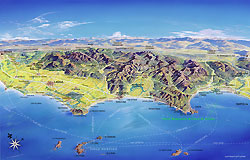|
|
PROVINCE OF LATINA
|
|
|
 |
The Province of Latina was established in 1934, is divided into 33 Municipalities and has a population of approx. 500,000. It extends across a surface area of 2,250 km2, almost equally divided between hilly and mountainous areas (Mt. Lepini, Mt. Ausoni and Mt. Aurunci) and coastal plains (the Pontina flatlands, Fondi-Monte San Biagio and Garigliano flatlands).
Its geographic features and the antiquity of the human settlements make it a complete area. In fact, the sea, mountains, islands, hot springs (Suio), national and regional parks, natural, archaeological and medieval monuments and modern settlements “live together” here.
|
It is very easily accessed: by air, Fiumicino and Ciampino airports (Rome) and Capodichino (Naples). Fiumicino Airport is linked to Rome-Stazione Termini by a train, the "Leonardo Express", that runs daily every half hour, starting at 6:37 and non-stop until 23:37; the trip takes 35 minutes; in the opposite direction (Rome-Stazione Termini – Fiumicino Airport), the service begins at 5:52 and ends at 22:52, running, once again, every half hour. For further information see www.trenitalia.it. The fastest connection between Ciampino airiport and Rome -Stazione Termini is by bus ("Terravision" or "Sit-Shuttle"), leaving from outside the "Departure" area; the run time is approx. 45 minutes. From Rome-Stazione Termini to Ciampino, the departure point is from Via Marsala (facing the Terracaffé); for departure times, see the site www.terravision.eu. Capodichino airport is not far from the Railway station of Napoli Centrale (5-10 minutes); it is advisable to take the special A.N.M. bus (Alibus) that leaves from outside the "Arrival" area. For further information, check www.anm.it. By car: Autostrada del Sole, with exits at Valmontone and Colleferro (north), Frosinone (centre) and Ceprano and Cassino (south); S.S.148 Pontina and S.S.7 Appia from the north; Domiziana and S.S.7 Appia from the south. By train, “Direttissima” Rome-Naples, connecting the Municipalities of Cisterna di Latina, Latina, Sezze, Priverno-Fossanova, Monte San Biagio, Fondi, Itri, Formia and Minturno Scauri, from which all the others are easily reached. There are also direct connections Roma Termini-Terracina. For departure times and tickets, see www.trenitalia.it.
The coastline of the province extends for a hundred kilometres, from the Astura River to the West to the borders with the province of Rome, and all the way to the Garigliano River to the East, which signals the Lazio border with Campania and separates the province of Latina from that of Caserta. Beaches of fine sand alternate with rocky promontories, in a design that creates a great variety of environments. Coastal centres are Latina Lido, Sabaudia, San Felice Circeo, Terracina, Fondi Lido, Sperlonga, Gaeta, Formia and Minturno-Scauri (in addition, of course, to the Pontine Islands). Concentrated in these areas is a suitable, diversified supply of hotels, a vast number of available campsites and a wealth of accommodations in holiday villas, houses and apartments, farm holidays and Bed&Breakfast. There are tourist ports at San Felice Circeo, Terracina, Sperlonga, Gaeta, Formia and Scauri; and landings on the Rio Martino River (Latina and Sabaudia), Sisto and Badino (Terracina), Garigliano (Minurno). The maritime sector is the most important tourist sector in the province, hosting the most bathing spots in Lazio and central Italy. The small, but charming, Archipelago of the Pontine Islands, in the centre of the Tyrrhene, is composed of two groups: Ponza (municipality) to the northwest, Palmarola, Zannone and Gavi (the latter islets being uninhabited), Ventotene (municipality) and S. Stefano (uninhabited) to the southeast. The islands are all of volcanic origin (except for Zannone), this fact bestowing on the earth a wealth of extraordinary colours, magical places, and deep, clear shoals. The islands are connected via motorship and hydrofoils from Formia, Terracina, San Felice Circeo (seasonal) and Anzio (Rome).
More than half the territory and two-thirds of the municipalities fall within the hilly-mountainous strip. Thus, one has the unique geographic situation of a province with a coastline along its entire length and chains of hills and mountains, also along its entire length, running parallel to the seacoast. Since ancient times, centres such as Cori, established before Rome, Roccamassima, Norba (where Norma stands today), Sezze, Lenola and Itri rose on the high grounds. Many other centres were settled during the Middle Ages: Sermoneta, Bassiano, Roccagorga, Maenza, Sonnino, Prossedi, Pisterzo, Priverno, Roccasecca dei Volsci, Monte San Biagio, Campodimele, Maranola, Castellonorato, Trivio, Castelforte and SS. Cosma and Damiano, Spigno Saturnia; they preserve their original character in most of the urban fabric, buildings and churches.
The province of Latina has various green areas. The most important (approx. 8,000 hectares) is the National Park of Circeo, which includes part of the municipal territory of Latina, Sabaudia, San Felice Circeo and Ponza (the islet of Zannone). In addition, three regional parks: the Regional Park of Monti Aurunci; the Regional Park of the Riviera of Ulysses, established in 2003 and consisting of three areas linked by special environmental and cultural values: the protected areas of Monte Orlando and Gianola-Monte di Scauri and the Monument of the Natural Promontory of the Villa of Tiberius and Costa Torre Capovento-Punta Cetarola with the related Blue Oasis; the newly set up (2009) Regional Park of Monti Ausoni and Lago di Fondi, which incorporated the existing natural monuments of Camposoriano (between Terracina and Sonnino), the Temple of Jupiter Anxur (Terracina), Lago di Fondi and Mola della Corta-Settecannelle-Capodacqua, (Fondi), Cima del Monte-Acquaviva-Quercia del Monaco (Lenola); to these areas are added the Natural Marine and Land Reserve, Island of Ventotene and Santo Stefano and the natural monuments of the Gardens and Ruins of Ninfa (Cisterna and Sermoneta), pride of the naturalistic patrimony for the abundance and variety of plants and flowers coming from all corners of the world, Lago di Giulianello (Cori), Torrecchia Vecchia (Cori and Cisterna di Latina). |
|
|



